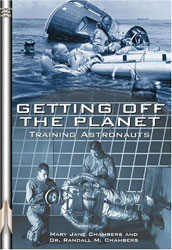
Before the U.S.’s Mercury mission placed people in orbit, the U.S. sent chimpanzees to test the physiological impact of space travel. Before either of these, people and animals were subject to simulations of the high acceleration of lift off as well as the micro-gravity of space. Of course, as the rockets weren’t ready, other test devices were needed. Thus, using ingenuity, trial and perseverance, people gathered the background knowledge for putting a human into space and having them undertake a useful role during their voyage.
Dr. Chambers was the head of the Human Engineering Division of the Aviation Medical Acceleration Laboratory. In this role, he prepared experiments and trials that built confidence in the success of human space flight. Extreme experiments included a 24 hour exposure to a 2G force that simulated a mission to Mars and bungee cords placed along a wall to simulate bouncing along in the lighter Moon gravity. With human space flight just beginning, almost everything undertaken was original but all had role in preparing the astronauts. In keeping with standard research and development, a prescriptive series of steps were used to resolve each increment of research. And Dr. Chambers was at the centre of the action, though it is Mary Chambers who wrote this book.
Mary Chambers is Dr. Chambers’ wife and thus she had a ring-side view of the experiments, experimenters and subjects. From this perspective, she provides a charming and witty account of the goings-on of her husband and cohorts. In a more familial than technical narrative, she discuses how her husband developed a research methodology and then she discusses many of the experiments themselves. Often Dr. Chambers was the test subject in these original trials which of course brings in many spousal concerns. She continues on to present a more emotional aspect of the training; the fears and uncertainties of the subjects, the boundless curiosity of the testers and their unifying desire for success. Her view is warmly candid and evocative of the time.
This book is a short, well illustrated memorial to the Chambers family and the work accomplished by Dr. Chambers. Many references to the Mercury astronauts and even Ham the chimpanzee show how closely the family was integrated into the space program. There is a certain lack of technical issues or contributions to science. A simple statement of the establishment of principles and standards of human capabilities and limitations’ is made without more detail. In spite of this, Mrs. Chambers does provide a nice tie-in between this space research and today’s physiological understanding such as the detrimental effects of extensive bed rest. However, this book isn’t a technical reference; rather it’s a folksy memorial to a vibrant time and one family’s contribution.
Travelling into the unknown is fun but also scary. Simulations and training can reduce the fear so that people can continue making contributions, even while experiencing new environments. Mary Jane Chambers and Dr. Randall Chambers in their book Getting Off the Planet show the depth of research needed to prepare humans for space flight. With such effort, astronauts were able to navigate in space, perform orbital rendezvous and competently travel on the Moon’s surface.
Review by Mark Mortimer
